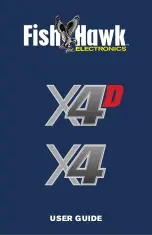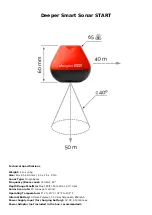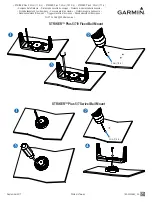
TRACKFISH 6500
Installation and Operation Manual
37
NAVMAN
8-4 Fish detection and display
Where to find fish
Underwater features like reefs, wrecks and
rocky outcrops attract fish. Use the 50 kHz or
50/200 kHz frequency display to find these
features, then look for fish by passing over the
feature slowly several times using the Zoom
display (see section 9-2). If there is a current,
the fish will often be found downstream of the
feature.
When fishing with the TRACKFISH with the
Fish symbols
Off
,
a weak fuzzy band may
appear between the bottom trace and surface.
This might indicate a thermocline - a rapid
change in water temperature, such as the edge
of a warm or cold current. The temperature
difference can form a barrier which the fish
may not swim through. In fresh water, fish
often collect around a thermocline.
Fish symbols
The TRACKFISH uses NAVMAN’s SBN
technology to analyse sonar echoes and
identify which are likely to be fish. The
TRACKFISH can be set up to display a fish
symbol and the depth over these echoes (see
section 17-3, Fish symbols). While SBN is very
sophisticated it is not foolproof - there will be
times when the TRACKFISH will not be able
to differentiate between fish and large air
bubbles or rubbish.
Depending on the strength of a fish signal,
the TRACKFISH can display a small, medium or
large symbol (see section 17-3, Fish filter).
To see the maximum amount of information
from the echoes, turn Fish symbols off. Fish
appear as arches on the display.
Fish arches
In good conditions, a fish passing through the
cone-shaped ultrasonic pulse is displayed as
a fish arch. The 50 kHz frequency uses a wider
cone than the 200 kHz frequency. This makes
the fish arches easier to see.
A fish arch starts when a fish enters the weak
edge of the sonar cone, generating a weak
echo that is displayed as the start of the fish
arch. As the fish moves closer to the middle of
the cone, the distance between the transducer
and the fish reduces and the echo is displayed
at progressively shallower depths, producing
a rising shape. When the fish passes directly
beneath the middle of the cone, the echo
becomes strongest and thickest. As the fish
passes out of the middle of the cone the
reverse happens with a progressively weaker
and deeper echo.
There are many reasons why fish arches may
not be seen. For example:
•
Poor transducer installation (see
Transom
Transducers Installation Guide
).
•
If the boat is anchored then fish will tend
to show on the display as horizontal lines
as they swim into and out of the transducer
sonar beam. Slow speeds in deeper water
give the best fish arch returns.
•
Range is important. It will be much easier
to see fish arches when using zoom mode
to concentrate on a particular section
of water, rather than just displaying
everything from the surface to the bottom.
Zooming increases screen resolution and is
necessary for good fish arches.
•
It is difficult to get fish arches in shallow
water as the transducer sonar beam is very
narrow near the surface and fish do not stay
within the beam long enough to display an
arch. Several fish in shallow water tend to
display as randomly stacked areas of colour.
• Wave motion may result in distorted fish
arches.
Fun fish symbol
Normal fish symbol
Fun depth
Fish arch



































